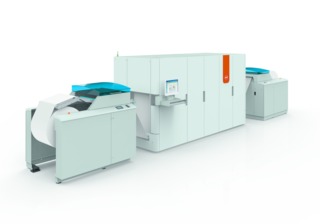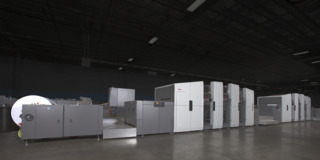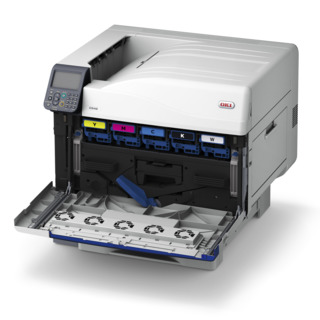Quality Over Quantity
Popularity of the digital color production press continues to grow as specialty papers and inks become more functional in the digital world.

The quality of digital color production presses can now rival that of the more traditional offset presses with constant improvements in inkjet technology and the ability to handle a plethora of substrates, offering print service providers (PSPs) increased personalization, quicker turnaround times, and variable print runs.
“Inkjet buyers are becoming more sophisticated,” noted Will Mansfield, WW sales and marketing inkjet presses, Enterprise Inkjet Systems Division, Kodak. “They are now keeping a keener eye on productivity, quality, and cost; buying decisions are moving more to a return on investment calculation.”
Speaking of quality, a trend towards lower print volume, but higher value printing has recently been highlighted by market intelligence firm Smithers Pira. According to the firm, digital pages are expected to have a seven percent compound annual growth rate (CAGR) worldwide between 2015 and 2020. “We see the penetration of digital pages growing from 2.6 percent in 2015 to 3.7 percent of all production pages (analog plus digital) by 2020,” the research stated. “Digital pages are of higher value than analog pages and the digital penetration of retail value of total production print will grow from 15 percent in 2015 to 18 percent in 2020. This digital growth will be led by inkjet page growth at 13 percent CAGR with xerographic page growth of three percent CAGR.”
Value trumps volume these days. Fabrizio Soto, vice president, Marketing, Production Printing, and Wide-Format, OKI Data Americas, pointed out that “Although traditional presses are capable of producing extremely high volumes on a lower cost-per-page basis than digital devices, the flexibility, speed, and growing feature sets of digital can easily produce much higher value output than offset. When all of the costs and time associated with set-up on traditional devices is taken into consideration, there are great economies of time—and ultimately cost—that can be achieved with digital.”
According to Mansfield, up to now, the roll-fed inkjet press market has been characterized largely by narrow format devices using drop on demand writing systems with most of these devices being purchased to print transaction or simple direct mail solicitation letter jobs on uncoated papers with limited ink coverage. However, he explained, the writing system, drying, and image quality management of this class of device has not been capable of achieving the quality, productivity, or economics required to migrate mainstream commercial jobs from offset to inkjet. “Going forward,” noted Mansfield, “we can expect to see a wider range of print applications moving to inkjet that feature greater ink coverage, glossy papers, and increased print quality overall. But this will only be possible through the use of high-end inkjet presses, like the PROSPER 6000 line.”
Emerging Personalization
The range of digital applications is increasing and volumes are mounting in nearly every market segment due to personalization and customization capabilities of digital production presses.
“Statements, transactional documents, explanation of benefits, bills, etc., are all printed on digital devices due to their need for precise personalization,” explained Michael Poulin, director of marketing, Production Print Solutions, Canon Solutions America. “This used to be the top application for digital printing—especially inkjet printing—but now both are moving into the direct mail and commercial printing space. Digital printing is an excellent option for direct mail applications, especially applications which incorporate personalization or versioning (by purchasing habit or geographic location). Books are also a great application. Book printers no longer need to print and store high volumes of titles, but instead, they can print books specifically for purchase orders in run lengths as small as single digits. Production inkjet color technology has exploded in the last two years and machines like the Oce VarioPrint i300 are capable of producing full-color output at a quality that rivals toner. The aforementioned applications have already moved into the digital world, and we expect to see that trend continue.”
That sentiment was echoed by Jacob Shamis, Americas market development manager, HP Indigo and PageWide Web Press. Shamis said he sees a wide mix of business cards, posters, catalogs, photo albums, greeting cards, and more being printed digitally and that while some of these applications are personalized with variable data and are best suited for digital printing, others are pure transfers of “static” runs with no variable print that are now more cost effective to produce digitally than traditionally.
“We’ve also seen that these transferred runs are getting longer and longer. For segments such as labels, applications are moving beyond pressure-sensitive labels to more shrink sleeves and in-mold labels, for both narrow-web and mid-web applications,” Shamis noted. “For flexible packaging and folding cartons, where HP Indigo customers are spearheading the revolution in digital print, we are already witnessing a large range of digitally-printed campaigns from small and major global brands alike—and this is only the very beginning.”
Substrates Rising
Paper is never just paper in the print media industry. It can be thin or thick, smooth or coarse, matte or shimmery, small-format or wide-format, or even plastic. One major driver for the digital commercial press’ popularity is its ever-evolving ability to print on various media and the list of substrates keeps on building as new technologies become available.
“We are seeing an increase in media versatility for production inkjet devices,” commented Poulin. “More and more papers, especially standard non-inkjet treated papers, are coming to market and giving printers more options for their customers’ applications.” Mansfield concurred by adding that paper will have a big impact on the inkjet press market in the next 18 months. “As inkjet presses become more capable, they require a wider variety of inkjet paper types, improved availability, and better consistency. Gloss papers and lightweight coated papers are two of the more frequently requested papers today,” he explained.
“We’re seeing PSPs ask for more media options for digital printing—especially inkjet printing,” said Poulin. “Because more jobs are being printed digitally, paper companies are working directly with equipment manufacturers to increase their paper offerings for digital presses.”
Just this year at drupa, Canon showed off the Océ ColorStream 6000 Chroma, featuring the new Chomera ink set. The high pigment load of the Chromera inks extends the application range of the press to lighter weight media with reduced ink show-through, and enables the delivery of higher-quality documents on uncoated or inkjet treated papers. Poulin also pointed to Canon’s ColorGrip option for the Océ VarioPrint i300. ColorGrip is an inline paper conditioning step that expands the choice of media, enabling high-quality inkjet printing on commodity stock, from light to heavy weight, which would otherwise deliver unacceptable print quality. “The introduction of ColorGrip allows PSPs to print on a wider variety of cost-effective papers, including standard uncoated and offset coated media, and to comfortably manage blended offset, toner, and inkjet production without the need for different types of paper and without compromising on quality.”
Also at drupa, Presstek showcased its DI ECO-UV digital offset press, featuring on-press chemistry-free imaging and offering integrated ECO-UV, an inline curing system that dries sheets instantly, improving overall job productivity and enabling customers to print on plastics and vinyl, in addition to traditional paper and board. DI ECO-UV printing capabilities include plastic items such as reward cards, membership cards, promotional items, and packaging components. “We see PSPs asking for ways to easily produce and offer their customers the highest print quality on wider variety of substrates in the most efficient way at a low cost,” noted Jonelle Rexenes, marketing manager, Presstek.
Get Inked
Vibrant and reliable color is exceedingly important to PSPs. Having a wide range of dye options that provide consistent results and can handle large workloads is what users are demanding and the digital color press industry has been listening.
“Inkjet technology is opening the door for print shops to produce more in-demand, profitable applications faster and more efficiently than ever before,” explained Beth Ann Kilberg-Walsh, vice president, marketing communications and customer engagement, Graphic Communications Business Group, Xerox. “Today’s production inkjet offerings are transforming the graphic communications industry with key technology enhancements that enable an easier path to entry, greater productivity, lower production economics, and improved flexibility.”
Canon is seeing the same improvements in inkjet ink sets, which Poulin said now rivals the look of offset and toner. “ColorGrip for the Océ VarioPrint i300 and Chomera Ink Set for the Océ ColorStream 6000 and Océ ColorStream 3000Z are improving the look and feel of inkjet print output and can produce a quality comparable to toner, but at a lower price point.”
Presstek is on board with ink, as well, with its introduction of DI AutoColor, a precise color management system to provide highly-consistent color, reduce makeready times, and help minimize ink and substrate waste. Ink is dripping with improvements and isn’t stopping anytime soon.
Crystal Ball Predictions
No matter how believable the Psychic Friends Network may seem, no one truly knows what the future holds; however, market research and current trends certainly provide a healthy outlook for digital production presses, showing that inkjet pages are expected to grow more than toner pages in the next few years. More specifically, inkjet pages are expected to represent nearly 60 percent of all digital pages printed in the U.S. by 2019.
“It’s clear that the market has accepted and fostered the proliferation of production inkjet and we expect to see more pages migrate from toner to inkjet in the next five years,” noted Poulin. “As more companies invest in inkjet devices in the next five years, we expect to see a significant jump from both offset and digital toner pages to inkjet. This will be driven by inkjet technology improvements as well as the lower running costs of inkjet devices compared to toner devices.”
Soto shared that the business that drove the initial migration from offset to digital was based on high volume runs on high volume (“big iron”) devices and that over the past few years, competition among leading manufacturers in the industry has driven prices down dramatically in the market. “As a result, there is a growing set of challenges emerging for print providers requiring them to go beyond the traditional volume-based business model and move to one that includes ‘value-based’ applications,” Soto noted. “These ‘value-based’ applications are ones that typically go beyond CMYK printing and cut-sheet media to an area that includes applications enabled by a 5th station.” When Soto looks into the crystal ball he sees this being an emerging area that will see significant growth over time.




